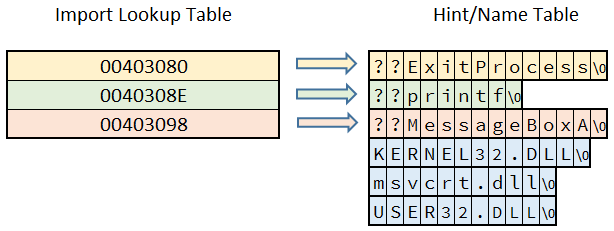When disassembling/dumping exe I get three tables in the .idata import section:
- import table (IT)
- import adress table (IAT)
- import name table (INT)
I understand what the IAT and INT are, but what is IT more exactly?
Could someone provide explanation, as various PE tutorials are confusing. I don't exactly understand what those official structure names they describe map here on this specific data.
Hints/Answers here would be helpful
Example PE File Section
SECTION .idata align=4 noexecute ; section number 3, data
Import_table: ; dword
db 50H, 30H, 00H, 00H, 00H, 00H, 00H, 00H ; 00403000 _ P0......
db 00H, 00H, 00H, 00H, 0ACH, 30H, 00H, 00H ; 00403008 _ .....0..
db 68H, 30H, 00H, 00H, 58H, 30H, 00H, 00H ; 00403010 _ h0..X0..
db 00H, 00H, 00H, 00H, 00H, 00H, 00H, 00H ; 00403018 _ ........
db 0C0H, 30H, 00H, 00H, 70H, 30H, 00H, 00H ; 00403020 _ .0..p0..
db 60H, 30H, 00H, 00H, 00H, 00H, 00H, 00H ; 00403028 _ `0......
db 00H, 00H, 00H, 00H, 0D0H, 30H, 00H, 00H ; 00403030 _ .....0..
db 78H, 30H, 00H, 00H, 00H, 00H, 00H, 00H ; 00403038 _ x0......
db 00H, 00H, 00H, 00H, 00H, 00H, 00H, 00H ; 00403040 _ ........
db 00H, 00H, 00H, 00H, 00H, 00H, 00H, 00H ; 00403048 _ ........
db 80H, 30H, 00H, 00H, 00H, 00H, 00H, 00H ; 00403050 _ .0......
db 8EH, 30H, 00H, 00H, 00H, 00H, 00H, 00H ; 00403058 _ .0......
db 98H, 30H, 00H, 00H, 00H, 00H, 00H, 00H ; 00403060 _ .0......
Import_address_table: ; dword
imp_ExitProcess: ; import from KERNEL32.dll
dd 00003080H, 00000000H ; 00403068 _ 12416 0
imp_printf: ; import from msvcrt.dll
dd 0000308EH, 00000000H ; 00403070 _ 0000308E 00000000
imp_MessageBoxA: ; import from USER32.dll
dd 00003098H, 00000000H ; 00403078 _ 00003098 00000000
Import_name_table: ; byte
db 17H, 01H, 45H, 78H, 69H, 74H, 50H, 72H ; 00403080 _ ..ExitPr
db 6FH, 63H, 65H, 73H, 73H, 00H, 0B1H, 02H ; 00403088 _ ocess...
db 70H, 72H, 69H, 6EH, 74H, 66H, 00H, 00H ; 00403090 _ printf..
db 0B2H, 01H, 4DH, 65H, 73H, 73H, 61H, 67H ; 00403098 _ ..Messag
db 65H, 42H, 6FH, 78H, 41H, 00H, 00H, 00H ; 004030A0 _ eBoxA...
db 00H, 30H, 00H, 00H, 4BH, 45H, 52H, 4EH ; 004030A8 _ .0..KERN
db 45H, 4CH, 33H, 32H, 2EH, 64H, 6CH, 6CH ; 004030B0 _ EL32.dll
db 00H, 00H, 00H, 00H, 14H, 30H, 00H, 00H ; 004030B8 _ .....0..
db 6DH, 73H, 76H, 63H, 72H, 74H, 2EH, 64H ; 004030C0 _ msvcrt.d
db 6CH, 6CH, 00H, 00H, 28H, 30H, 00H, 00H ; 004030C8 _ ll..(0..
db 55H, 53H, 45H, 52H, 33H, 32H, 2EH, 64H ; 004030D0 _ USER32.d
db 6CH, 6CH, 00H, 00H, 00H, 00H, 00H, 00H ; 004030D8 _ ll......
db 00H, 00H, 00H, 00H, 00H, 00H, 00H, 00H ; 004030E0 _ ........
db 00H, 00H, 00H, 00H, 00H, 00H, 00H, 00H ; 004030E8 _ ........
db 00H, 00H, 00H, 00H, 00H, 00H, 00H, 00H ; 004030F0 _ ........
db 00H, 00H, 00H, 00H, 00H, 00H, 00H, 00H ; 004030F8 _ ........
db 00H, 00H, 00H, 00H, 00H, 00H, 00H, 00H ; 00403100 _ ........
db 00H, 00H, 00H, 00H, 00H, 00H, 00H, 00H ; 00403108 _ ........
db 00H, 00H, 00H, 00H, 00H, 00H, 00H, 00H ; 00403110 _ ........
db 00H, 00H, 00H, 00H, 00H, 00H, 00H, 00H ; 00403118 _ ........
db 00H, 00H, 00H, 00H, 00H, 00H, 00H, 00H ; 00403120 _ ........
db 00H, 00H, 00H, 00H, 00H, 00H, 00H, 00H ; 00403128 _ ........
db 00H, 00H, 00H, 00H, 00H, 00H, 00H, 00H ; 00403130 _ ........
db 00H, 00H, 00H, 00H, 00H, 00H, 00H, 00H ; 00403138 _ ........
db 00H, 00H, 00H, 00H, 00H, 00H, 00H, 00H ; 00403140 _ ........
db 00H, 00H, 00H, 00H, 00H, 00H, 00H, 00H ; 00403148 _ ........
db 00H, 00H, 00H, 00H, 00H, 00H, 00H, 00H ; 00403150 _ ........
db 00H, 00H, 00H, 00H, 00H, 00H, 00H, 00H ; 00403158 _ ........
db 00H, 00H, 00H, 00H, 00H, 00H, 00H, 00H ; 00403160 _ ........
db 00H, 00H, 00H, 00H, 00H, 00H, 00H, 00H ; 00403168 _ ........
db 00H, 00H, 00H, 00H, 00H, 00H, 00H, 00H ; 00403170 _ ........
db 00H, 00H, 00H, 00H, 00H, 00H, 00H, 00H ; 00403178 _ ........
db 00H, 00H, 00H, 00H, 00H, 00H, 00H, 00H ; 00403180 _ ........
db 00H, 00H, 00H, 00H, 00H, 00H, 00H, 00H ; 00403188 _ ........
db 00H, 00H, 00H, 00H, 00H, 00H, 00H, 00H ; 00403190 _ ........
db 00H, 00H, 00H, 00H, 00H, 00H, 00H, 00H ; 00403198 _ ........
db 00H, 00H, 00H, 00H, 00H, 00H, 00H, 00H ; 004031A0 _ ........
db 00H, 00H, 00H, 00H, 00H, 00H, 00H, 00H ; 004031A8 _ ........
db 00H, 00H, 00H, 00H, 00H, 00H, 00H, 00H ; 004031B0 _ ........
db 00H, 00H, 00H, 00H, 00H, 00H, 00H, 00H ; 004031B8 _ ........
db 00H, 00H, 00H, 00H, 00H, 00H, 00H, 00H ; 004031C0 _ ........
db 00H, 00H, 00H, 00H, 00H, 00H, 00H, 00H ; 004031C8 _ ........
db 00H, 00H, 00H, 00H, 00H, 00H, 00H, 00H ; 004031D0 _ ........
db 00H, 00H, 00H, 00H, 00H, 00H, 00H, 00H ; 004031D8 _ ........
db 00H, 00H, 00H, 00H, 00H, 00H, 00H, 00H ; 004031E0 _ ........
db 00H, 00H, 00H, 00H, 00H, 00H, 00H, 00H ; 004031E8 _ ........
db 00H, 00H, 00H, 00H, 00H, 00H, 00H, 00H ; 004031F0 _ ........
db 00H, 00H, 00H, 00H, 00H, 00H, 00H, 00H ; 004031F8 _ ........





